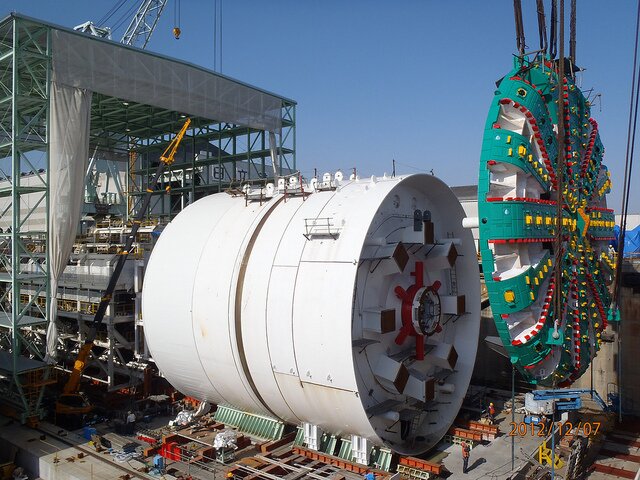[UPDATE: A spokesperson for Dragados USA says production of the tunnel liners resumed on Friday, July 12, 2013.]
Last week, the Tacoma News Tribune reported that the maker of the concrete tunnel liners for Seattle’s Viaduct replacement project, FPS EnCon, was coming apart at its joint-venture seams: “Tunnel liner builder FPS EnCon shows Frederickson workers the door.” The CEO of Denver-based EnCon United, Jim Sorensen, said that going forward his company would be a subcontractor on the project — FPS, a firm created by the Spanish construction enterprise Dragados USA, would manage the liners’ construction.
This development may be worrisome for tunnel-watchers familiar with Dragados USA’s performance in New York. Law 360 reported last year that:
The tunneling and concrete lining work awarded to Dragados and Judlau had been slated for delivery in February 2013. But the construction group informed the MTA in December that it was some 42 months behind schedule. Under the new agreement, the company will finish the tunneling but turn over responsibility for installing concrete linings to a new contractor.
Dragados’ new finish line on that project is this August. (This March, that East Side Access project was determined to be 10 years late and $4.4 billion over budget.)
While the EnCon reorganization is in progress, and subcontractors supplying the materials for the liners catch up to the $20-million plant’s demand, some 85 workers have been laid off. Though Sorensen admitted to some friction over the timeliness of payments from FPS, he denied that the layoffs were in response to a workers’ vote to join Laborers Local 252. (Non-union laborers get $10.50 per hour as a starting wage, $1.31 more than the state’s minimum wage of $9.19.)
In mid-May, the tunnel project was already a month behind schedule, with tunnel boring set to begin in July. Bertha, the $80-million, one-of-a-kind tunnel boring machine, spent longer in testing in Japan than anticipated after its main drive unit began making a strange noise and it had to be taken apart and reassembled.
The TBM requires a steady supply of tunnel liners to dig, as the liner segments form both the tunnel’s casing (keeping water and dirt out of the newly dug tunnel) and give the machine purchase for its push forward. Nine liner segments plus a “keystone” create about a six-foot-wide circle, 56 feet in diameter. About 1,000 of a total of 14,500 have been cast since February (the goal is 60 segments per day).
In Seattle’s case, neither the financing plan nor the timeline for removal of the Viaduct envision a worst-case prospect of significant delay and a doubling of costs. Tolling shortfalls have already created an ongoing controversy over who will pay, even if the project comes in on budget. State legislators continue to emphasize that the project will not get one dime in excess of that already allocated. Because it’s typical for large projects like this to take longer than estimated and come in over budget, the wisdom of a $3.1-billion project that simply replaces vehicular (or not, given freight restrictions and plenty of options for shunpikers) capacity will likely continue to be debated.
